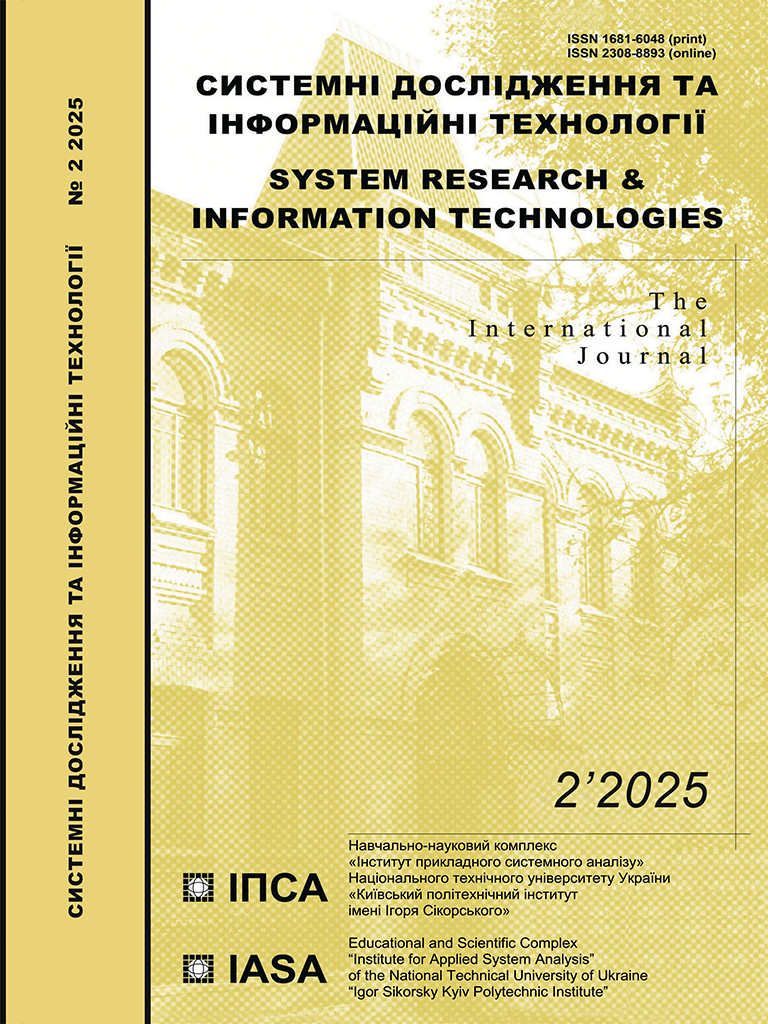Determining the level of propaganda in opera librettos using data mining and machine learning
DOI:
https://doi.org/10.20535/SRIT.2308-8893.2025.2.05Keywords:
art, propaganda, opera, libretto, multivariate model, statistical analysis, Data Mining, Machine Learning, information technologyAbstract
The article presents an adapted multifactorial model that can be used to determine the level of propaganda in librettos to world operas. This model was created using the linear convolution method, for which eight indicators were selected that are most effective in identifying elements of propaganda in the text, taking into account the subject area's peculiarities. Each of the selected indicators was calculated using statistical analysis, data mining, and machine learning methods. As a result of applying the proposed method, the value function is calculated for each libretto, based on which a conclusion is made as to whether it contains elements of propaganda or not.
References
Zongrui Zhang, “Model Opera” of the 20th Century in Chinese Musical Culture,” Art History Notes, no. 43, pp. 206–210, 2023. doi: https://doi.org/10.32461/2226-2180.43.2023.286862
W. Li, S. Li, C. Liu, L. Lu, Z. Shi, S. Wen, “Span identification and technique classification of propaganda in news articles,” Complex Intell. Syst., vol. 8, pp. 3603–3612, 2022. doi: https://doi.org/10.1007/s40747-021-00393-y
Maram Hasanain, Fatema Ahmed, Firoj Alam, “Can GPT-4 Identify Propaganda? Annotation and Detection of Propaganda Spans in News Articles,” Computation and Language (cs.CL), 2024. doi: https://doi.org/10.48550/arXiv.2402.17478
K. Hamilton, “Towards an Ontology for Propaganda Detection in News Articles,” in R. Verborgh et al. The Semantic Web: ESWC 2021 Satellite Events. ESWC 2021. Lecture Notes in Computer Science, vol. 12739. Springer, Cham, 2021. doi: https://doi.org/10.1007/978-3-030-80418-3_35
G. Da San Martino, S. Yu, A. Barrón-Cedeño, R. Petrov, P. Nakov, “Fine-grained analysis of propaganda in news article,” in Proceedings of the 2019 Conference on Empirical Methods in Natural Language Processing and the 9th International Joint Conference on Natural Language Processing (EMNLP-IJCNLP), Association for Computational Linguistics, pp. 5635–5645, 2019. doi: https://doi.org/10.18653/v1/D19-1565
G.L. Ciampaglia, P. Shiralkar, L.M. Rocha, J. Bollen, F. Menczer, A. Flammini, “Computational fact checking from knowledge networks,” PLoS One, 10(6), 15, 2015. doi: https://doi.org/10.1371/journal.pone.0128193
G. Pocheptsov, Modern information wars. Kyiv: Kyiv-Mogylianska Academy, 2015, 497 p.
S. Ghosal, A. Jain, “CatRevenge: towards effective revenge text detection in online social media with paragraph embedding and CATBoost,” Multimed Tools Appl., 83, pp. 89607–89633, 2024. doi: https://doi.org/10.1007/s11042-024-18791-y
R. Alhajj, J. Rokne (Eds), Encyclopedia of Social Network Analysis and Mining. Springer, New York, NY., 2018, 2200 p. doi: https://doi.org/10.1007/978-1-4614-7163-9
Ramona-Diana Leon, Raúl Rodríguez-Rodríguez, Pedro Gómez-Gasquet, Josefa Mula, “Social network analysis: A tool for evaluating and predicting future knowledge flows from an insurance organization,” Technological Forecasting and Social Change, vol. 114, pp. 103–118, 2017. doi: https://doi.org/10.1016/j.techfore.2016.07.032
Sergii Telenyk, Grzegorz Nowakowski, Olena Gavrilenko, Mykhailo Miahkyi, Olena Khalus, “Analysis of the influence of posts of famous people in social networks on the cryptocurrency course,” Bulletin of the Polish Academy of Sciences Technical Sciences, vol. 72(4), 2024. doi: https://doi.org/10.24425/bpasts.2024.150117
O. Gavrilenko, Y. Oliinyk, H. Khanko, “Analysis of Propaganda Elements Detecting Algorithms in Text Data,” in Z. Hu, S. Petoukhov, I. Dychka, M. He, (Eds) Advances in Computer Science for Engineering and Education II. ICCSEEA 2019. Advances in Intelligent Systems and Computing, vol. 938, Springer, Cham, 2020, pp. 438–447. doi: https://doi.org/10.1007/978-3-030-16621-2_41
O. Gavrilenko, K. Feshchenko, “Detecting propaganda in news flows,” Adaptive systems of automatic control, no. 1 (46), pp. 160–177, 2025. doi: https://doi.org/10.20535/1560-8956.46.2025.323759
V. Oliinyk, I. Matviichuk, “Low-resource text classification using cross-lingual models for bullying detection in the Ukrainian language,” Adaptive systems of automatic control, no. 1 (42), pp. 87–100, 2023. doi: https://doi.org/10.20535/1560-8956.42.2023.279093
Opera librettos and arias by foreign authors notes. Accessed on: Feb. 23, 2025. [Online]. Available: https://musicinukrainian.wordpress.com/biblio/import_opera/
Jürgen Branke, Kalyanmoy Deb, Kaisa Miettinen, Roman Słowiński, Multiobjective Optimization. Springer-Verlag Berlin Heidelberg, 2008, 470 p. doi: https://doi.org/10.1007/978-3-540-88908-3
Kalyanmoy Deb, Multi-Objective Optimization using Evolutionary Algorithms. Wiley, 2001, 536 p.
Ronald E. Walpole, Raymond H. Myers, Sharon L. Myers, E.Ye. Keying, Probability and Statistics for Engineers and Scientists; 9th ed. Pearson, 2016, 816 p.
Sheldon Ross, A First Course in Probability; 10th ed. Pearson, 2018, 528 p.
Operavision. Accessed on: Feb. 23, 2025. [Online]. Available: https://operavision.eu/
Rudolf Flesch, How to Write Plain English: A Book for Lawyers and Consumers. Harper & Row, 1979, 126 p.
Jure Leskovec, Anand Rajaraman, Jeffrey D. Ullman, Mining of Massive Datasets. Cambridge University Press, 2014, 326 p.
Giovanni Da San Martino, Seunghak Yu, Alberto Barrón-Cedeño, Rostislav Petrov, Preslav Nakov, “Fine-Grained Analysis of Propaganda in News Articles,” Computation and Language (cs.CL), 2019. doi: https://doi.org/10.48550/arXiv.1910.02517
P.G. Preethi, V. Uma, A. Kumar, “Temporal Sentiment Analysis and Causal Rules Extraction from Tweets for Event Prediction,” Procedia Computer Science, no. 48, pp. 84–89, 2015. doi: https://doi.org/10.1016/j.procs.2015.04.154

